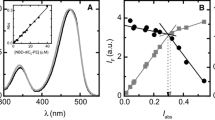Abstract
Liposomes formed from egg-yolk phosphatidylcholine:egg-yolk phosphatidate (molar ratio 2:1) containing pBR322 DNA and DNase I were induced to form, with divalent cations, bilayer/nonbilayer phase transitions of phosphatidate which allowed cation diffusion into liposomes; then cation diffusion was measured by the activation of the hydrolysis of DNase I on DNA. The formation of phosphatidate transitions on liposomes was demonstrated by freeze-fracture and 31P NMR, and a direct correlation between the formation of phosphatidate transitions and the transbilayer diffusion of cations was found: only Ca2+ and Mn2+, which induce phase transitions, were able to penetrate liposomes and triggered the DNase I activity; in addition, Ca2+ at higher concentrations (10 mM) caused fusion of liposomes, whereas Mn2+ did not, suggesting that transitions induced by Mn2+ participated only in the diffusion of this ion; furthermore, Mg2+ neither formed phase transitions nor triggered the enzymatic activity. The liposomes studied represent more dynamic structures that can form phosphatidate structures involved in both (1) the interchange of divalent cations with the surroundings, thereby modulating encapsulated enzymes, and (2) the fusion of lipid vesicles probably implicated in the enrichment of liposomal content in the early Precambian Earth.
Similar content being viewed by others
References
Baeza I, Gariglio P, Rangel LM, Chávez P, Cervantes L, Argüello C, Wong C, Montañez C (1987) Electron microscopy and biochemistry properties of polyamine-compacted DNA. Biochemistry 26: 6387–6392
Baeza I, Ibáñez M, Santiago JC, Argüello C, Wong C, Oró J (1990) Diffusion of Mn2+ ions into liposomes mediated by the activation of an encapsulated enzymatic system. J Mol Evol 31: 453–461
Baeza I, Ibáñez M, Wong C, Chavez P, Gariglio P, Oró J (1992) Possible prebiotic significance of polyamines in the condensation, protection, encapsulation, and biological properties of DNA. Orig Life 21: 225–242
Birnboinm HC, Doly J (1979) A rapid alkaline extraction procedure for screening recombinant plasmid DNA. Nucleic Acids Res 7: 1513–1523
Bottoger F, Vantgent M, Prices C (1961) A rapid and sensitive sub-microphosphorous determination. Anal Chim Acta 24: 203–204
Burton K (1956) A study of the conditions and mechanism of the diphenylamine reaction for the colorimetric estimation of deoxyribonucleic acid. Biochem J 62: 315–324
Cullis PR, Tilcock CF, Hope MJ (1991) Lipid polymorphism. In: Wilschut J, Hoekstra D (eds) Membrane fusion. Marcel Dekker, New York, pp 65–85
Deamer DW, Oró J (1980) Role of lipids in prebiotic structures. Biosystems 12: 167–175
Deamer DW, Barchfeld GL (1982) Encapsulation of macromolecules by lipid vesicles under simulated prebiotic conditions. J Mol Evol 18: 203–206
Fraley R, Subramani S, Berg P, Papahadjopoulos D (1980) Introduction of liposome-encapsulated SV40 into cells. J Biol Chem 255: 10431–10435
Gaillard S, Renou JP, Bonnet M, Vignon X, Dufourc EJ (1991) Halothane-induced membrane reorganization monitored by DSC, freeze-fracture electron microscopy and 31P-NMR techniques. Eur Biophys J 19: 265–274
Gagné J, Stamatatos L, Diacovo T, Hui SW, Yeagle PL, Silvius JR (1985) Physical properties and surface interactions of bilayer membranes containing N-methylated phosphatidylethanolamines. Biochemistry 24: 4400–4408
Gruner MS (1987) Materials properties of liposomal bilayers. In: Ostrom MJ (ed) Liposomes from biophysics to herapeutics. Marcel Dekker, New York, pp 1–38
Hargreaves WR, Deamer DW (1978) Liposomes from ionic singlechain amphiphiles. Biochemistry 17: 3759–3768
Jones GP, Misso NLA, Paleg LG (1992) Indole—acetic acid mediated transport of Mn2+ and other ions across phosphatidylinositol vesicular membranes as determined by 31P-NMR. Chem Phys Lipids 61: 175–184
Maniatis T, Fritsch EF, Sambrook J (1982) Molecular cloning—a laboratory manual. Cold Spring Harbor Laboratory, Cold Spring Harbor, NY
Nichols J, Deamer DW (1976) Catecholamine uptake and concentration by liposomes maintaining pH gradients. Biochim Biophys Acta 455: 269–271
Portis A, Newton C, Pangborn W, Papahadjopoulos D (1979) Studies on the mechanism of membrane fusion: Evidence for an intermembrane Ca2+-phospholipid complex, synergism with Mg2+, and inhibition by spectrin. Biochemistry 18: 780–790
Sharp RR (1992) Nuclear-spin relaxation in paramagnetic solutions when the electronic zero-field splitting and Zeeman interactions are of arbitrary magnitude. J Magn Reson Imaging 100: 491–516
Singh D, Jarrell HC, Barber KR, Grant CWM (1992) Glycosphingolipids: 2H NMR study of the influence of ceramide fatty acid characteristics on the carbohydrate headgroup in phospholipid bilayers. Biochemistry 31: 2662–2669
Stillwell W (1976) Facilitated diffusion of amino acids across biomolecular lipid membranes as a model for selective accumulation of amino acids in a primordial protocell. Biosystems 8: 111–117
Szoka F, Papahadjopoulos D (1978) Procedure for preparation of liposomes with large internal aqueous space and high capture by reverse-phase evaporation. Proc Natl Acad Sci USA 75: 4194–4198
Verkleij AJ, de Maagd R, Levnissen-Bijvelt J, de Kruijff B (1982) Divalent cations and chlorpromazine can induce non-bilayer structures in phosphatidic acid-containing model membranes. Biochim Biophys Acta 684: 255–262
Verkleij AJ (1984) Lipidic intramembranous particles. Biochim Biophys Acta 779: 43–63
Wilschut J, Düzgünes N, Fraley R, Papahadjopoulos D (1980) Studies of the mechanism of membrane fusion: kinetics of calcium ion induced fusion of phosphatidylserine vesicles followed by a new assay for mixing of aqueous vesicle contents. Biochemistry 19: 6011–6021
Author information
Authors and Affiliations
Additional information
Correspondence to: C. Argüello
Rights and permissions
About this article
Cite this article
Baeza, I., Wong, C., Mondragón, R. et al. Transbilayer diffusion of divalent cations into liposomes mediated by lipidic particles of phosphatidate. J Mol Evol 39, 560–568 (1994). https://doi.org/10.1007/BF00160401
Received:
Accepted:
Issue Date:
DOI: https://doi.org/10.1007/BF00160401




